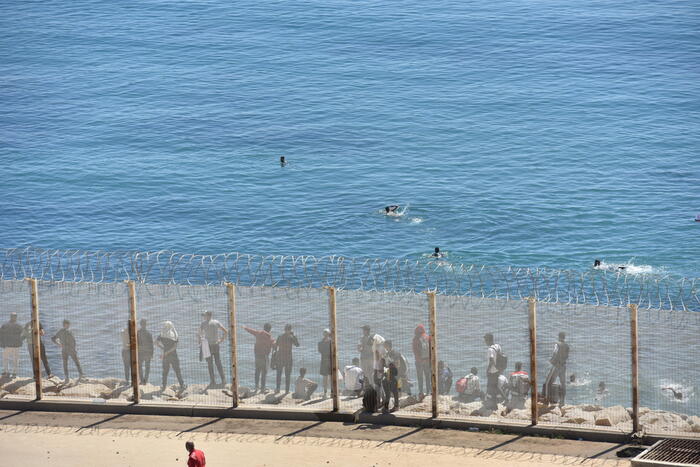A minor, who claims to have escaped from the Piniers emergency shelter in Ceuta to avoid being repatriated, dozes in a playground in August 2021. Luis de Vega
Ceuta, with just over 19 square kilometres, has endured pressure for months that has put a delicate demographic balance in check. In May 2021, some 1,500 minors managed to cross from Morocco, by swimming or avoiding the border fence. Many voluntarily returned to their country or were returned by the Spanish authorities. Some facts that the Prosecutor's Office is still investigating, after the illegal attempt at massive return that was stopped by the courts after the expulsion of 55 minors was frustrated in August. But several organizations have denounced that the trickle of summary repatriations has not stopped.
"The Government continues to return people, including minors," protests Francesca Fusaro, an activist from No Name Kitchen, an organization that has worked in Ceuta since the beginning of the crisis with people on the streets and that has documented at least six expulsions between October and December , “there is a repatriation procedure and the Executive is not complying with it”. If in September there were more than 700 minors whose guardianship the city government had to take over, at the beginning of January there are no more than 370 children and adolescents who still remain in the town, of 85,000 inhabitants.The regional Executive and the Provincial Directorate of the Ministry of Education have had to juggle to welcome and educate those who have stayed while it is resolved how to proceed to formalize the repatriation files that the Government of Pedro Sánchez promised to manage this year.
Many remain outside the system or have thrown themselves into the sea to reach the Peninsula.
The fear of being sent back to Morocco has made the kids prefer to be outside the centers managed by the Government of Ceuta and take the risk of boarding the regular boat lines to Algeciras or on their own boats.
"Every night they try to do riski (climb on the underside of trucks or ferry engines), enter or directly sleep in the port," explains Fusaro.
Five minors, one of them under the tutelage of the Administration, disappeared at the end of November after getting on an inflatable raft.
Stability in arrivals
The irregular arrival of migrants in Spain has continued in 2021 in a European context in which inflows have skyrocketed to record highs in 2017 and in a year marked by the unprecedented crisis with Morocco, a priority partner in migration policy on the southern border. Until December 28, 2021, latest data released by the Ministry of the Interior, 41,632 migrants arrived in Spain irregularly, 0.4% more than in 2020. More than half, to the Canary Islands, and most from the coast Moroccan Atlantic. The obvious figure, however, is the exodus that occurred across the land border with Ceuta in mid-May, when between 9,000 and 13,000 people crossed from Morocco to the autonomous city in just two days.
Cooperation with Morocco remains key, an asset that Rabat has been able to play to pressure the EU after the US recognized its sovereign aspirations over the Sahara. While tight control has been maintained with raids on migrants from third countries, especially Sub-Saharans in the north of the country, Rabat leaves the door open to the exodus of its own nationals on the Atlantic coast and around Ceuta and Melilla. Sources from the Government Delegation in Melilla see as extraordinary the pressure on the perimeter by Moroccan nationals who have tried to circumvent the fence in large groups, something that had not been experienced before in the city and that is explained, among other factors, bydue to the poor economic situation that a large part of the population is going through in the bordering areas that traditionally crossed to Melilla every day to work. The closure of the land border crossings since March 2022 has left many families without a livelihood and has pushed citizens to seek desperate solutions, such as resorting to the asylum procedure to be able to travel from Ceuta or Melilla to the Peninsula and look for work there.
For the first time since figures were recorded, Morocco is part of the top five countries of origin of asylum seekers in Spain, with 6,123 applications submitted until November 31, 2021, compared to 1,110 in 2020. The data exceeds the set of all applications registered between 2017 and 2019 (531 in 2017; 1,323, 2018; 2,559, 2019), when international protection applications by Rif activists escaping from the policy of repression of the Hirak movement by the authorities skyrocketed. Moroccan authorities. The spectacular growth masks an unprecedented flow of Moroccan immigration. In Ceuta, up to 3,078 asylum applications have been registered as of November 30, compared to the 285 processed in 2020; in Melilla, 2,985, almost double that recorded the previous year (1,421).
“From a legal point of view, it is an aberration,” says Josep Buades, coordinating lawyer for the Jesuit Migrant Service, one of the entities behind the complaints that led the Supreme Court to recognize in 2020 the freedom of movement of asylum seekers for throughout the territory of the State, "from the political point of view, they have found a practical way to give them an outlet to reside and work in Spain until their protection file is resolved."
The two main routes, with hardly any changes
In neither of the two main entry routes to Spain have there been significant changes, despite the fact that they had been marked as priorities on the Government's agenda.
The Canarian route remains open, without the number of arrivals having decreased compared to the maximum of 2020. The Algerian route, on the rise since 2019, has reached extraordinary quotas until surpassing Morocco in 2021 as the first country of origin of immigrants to Spain ( 9,580 Algerians have arrived by sea, compared to 8,494 Moroccans).









/cloudfront-eu-central-1.images.arcpublishing.com/prisa/IBM4BMDYA5ERBOQHEJXKOEPBAA.jpg)